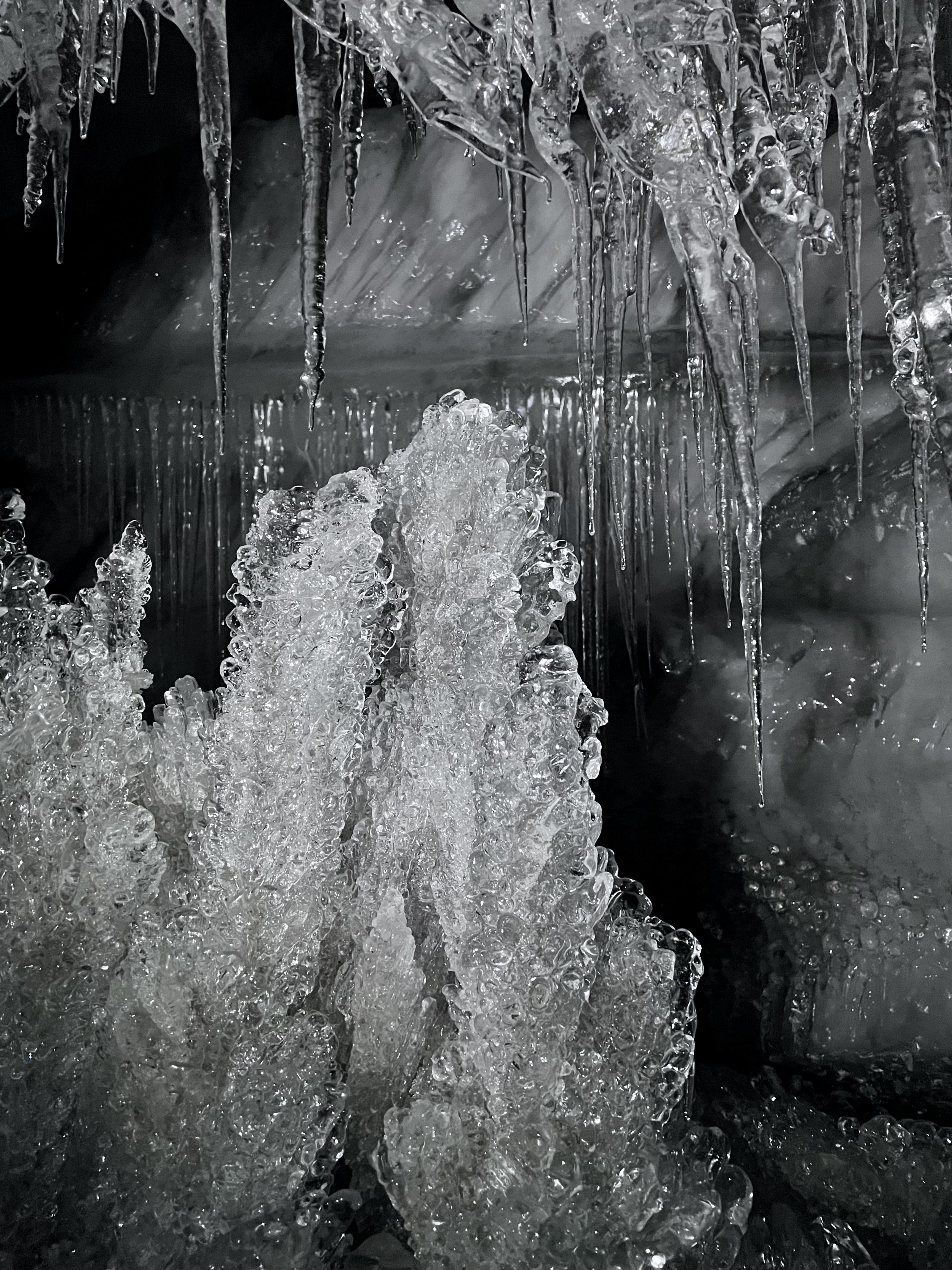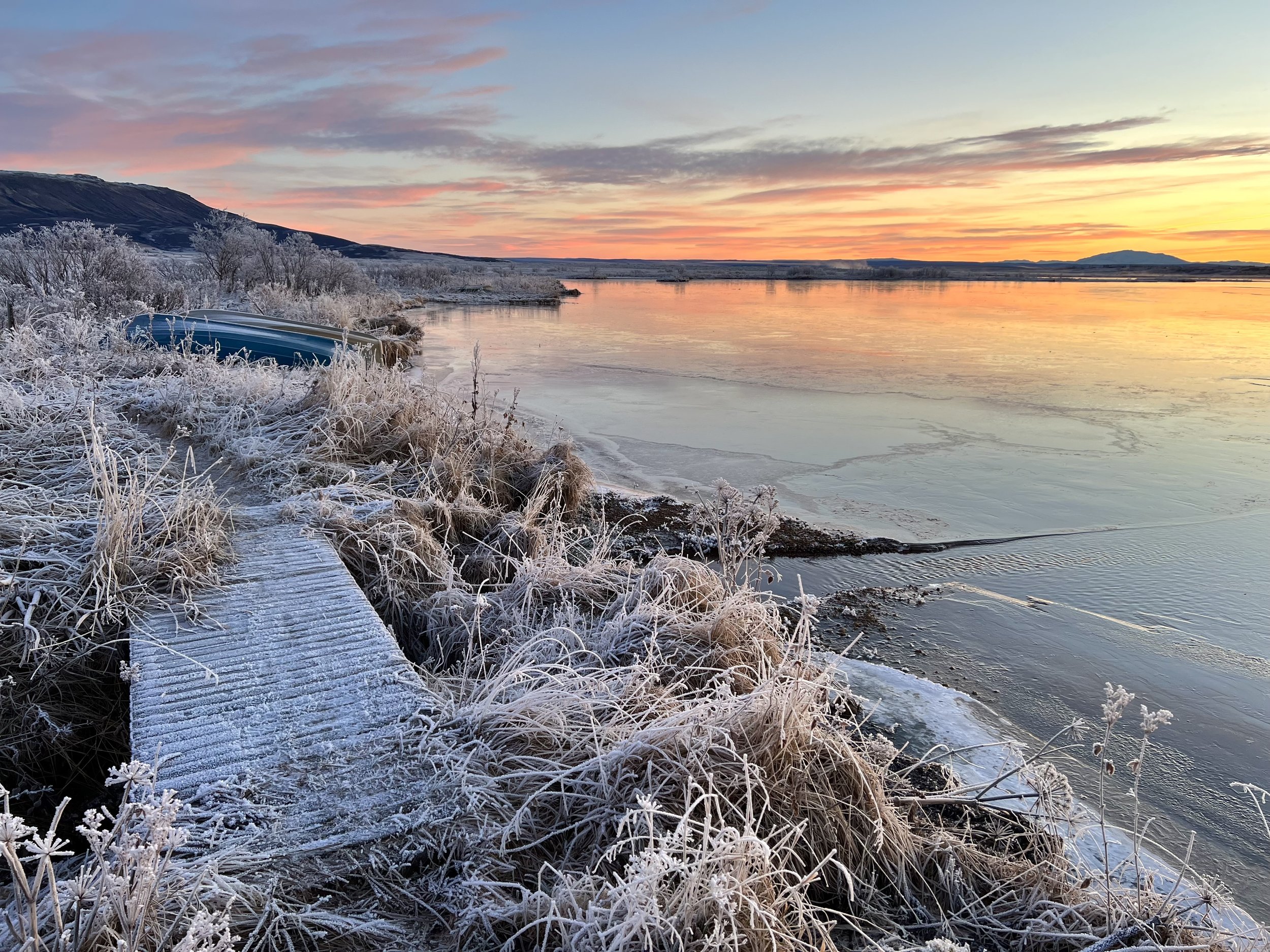
Iceland - Lapland - Svalbard - Norway
ICE
Precious
This drawing was inspired by the sturdy reindeer I’ve seen and beautiful ice caves I’ve explored while on Svalbard in the high Arctic. I remember thinking in the ice caves that it was like being in a cave full of diamonds. But then I thought no, this is far more beautiful, and more precious.
“Precious” explores our priorities and what we value and consider to have worth. The Svalbard reindeer is endemic to Svalbard, and is far more rare than any gem. The ice formations in the ice caves are sculpted by nature, fragile and ephemeral. Their beauty is more powerful and more timeless than any jewelry.
If we prioritized and valued nature the way we do material things, the world would be far better off.
The ridiculously cute Svalbard reindeer is a subspecies of reindeer endemic to the archipelago. They are the smallest species of reindeer, and have adapted to the specific environment of Svalbard in several ways.
For example, their feet are shaped specially for digging in the snow for their preferred food, lichens and moss. Their noses are designed to retain moisture in this dry air, while heating the air going into their lungs. Their fur is incredibly dense and the individual hairs are hollow, which increases insulation. The female of this species grows antlers as well as the males, in order to defend the food territory she needs while she is pregnant.
While Svalbard reindeer have formerly had no natural predators, polar bears have begun hunting them as sea ice retreats and takes the opportunity for hunting seals with it.
Isbjørn
Some animals, like the apple snail, can live in many different types of ecosystems. But polar bears can only survive in one ecosystem- areas with arctic ice.
Unfortunately for polar bears, global warming is melting the ice they rely on at an alarming rate. The volume of ice in the Arctic has decreased by a third over the past twenty years, and the rate of decrease is accelerating. Climate scientists have suggested that by 2040, the arctic could experience an ice-free summer.
Polar bears rely on arctic sea ice to hunt. Their preferred prey, seals, live in the ocean underneath the ice. Without ice to roam on, polar bears can’t hunt seals, or any other life-sustaining prey. They also rely on the ice to breed, and sometimes to build dens. More than 96% of a polar bears critical habitat is sea ice.
Fragility
“Fragility” expresses the delicate and easily destroyed nature of our natural world and ecosystems. The teacup, being man-made, represents man’s hold on nature and how our care is the vessel of the fate of the environment and its inhabitants. The teacup is specifically inspired by the vintage Heisey teacups and represent how humans have been affecting the environment for generations. Heisey glassworks were expensive and generally owned by the wealthy. They are also very delicate and fragile, and given the kind of care and attention that should also be given to the climate crisis.
Two of the whales are humpbacks, which were only very recently removed from the critically endangered species list, and the third whale is a North Atlantic right whale. North Atlantic right whales are critically endangered and are expected to become functionally extinct in just a few decades. Above the whales float several icebergs, which are spilling over the edge of the broken cup bit by bit. The earth is losing approximately 1.2 trillion tons of ice per year due to climate change.The three birds are arctic terns, which do not often come into human contact. They are free and thriving in the clouds, apart from the broken teacup and human environmental destruction.
Sacrifice
Apathy and greed of those in positions of wealth and power are detrimental to the climate crisis. “Sacrifice”, shows an aged man’s hand holding a whiskey glass. The suit sleeve, Rolex, and rings suggest wealth and materialism, and the neatly groomed fingernails suggest someone who would never “get their hands dirty”.
The ring on the pointer finger has very particular symbolism- the ring is a signet ring; a ring that is usually passed down and is a sign of generational wealth and privilege. The stone of the signet ring is bloodstone. Bloodstone is said to have been “created” from the blood of Jesus as it dripped onto the jasper rock at the feet of his crucifix. Hence, it is known as the gem of noble sacrifice and is worn by those who possess an altruistic and selfless character (or think that they do…notice how the ring doesn’t fit). The stone is engraved with a skull and vines, representing nature and death, as well as the words “noble sacrifice” in Latin.
In the carelessly handled whiskey glass float chunks of melting glacial ice, and a struggling polar bear. Polar bears are currently vulnerable and facing a high risk of extinction. The polar ice caps are melting at an alarming rate of 9% per decade, with Antarctica losing ice mass at an average rate of about 150 billion tons per year. The faceless, emotionless hand holds the glass casually and carelessly, without much thought or concern towards its contents other than the benefit to the owner of the hand.
While in Iceland I have marveled at the beautiful glacial ice, but knowing that the glaciers are rapidly receding gives the beauty a tragic tinge.
Polar Flight
This drawing was inspired by the northern lights and glacial ice I have seen while above the Arctic circle, as well as by the humpbacks of the polar oceans.
It was also inspired by the climate crisis and the unfortunate need for wildlife to drastically adapt to the extreme environmental conditions caused by human activity.
Choose One
A commentary on big oil and multimillion dollar companies and their consistent and relentless prioritization of profit over the environment.
Like
“Like” explores humanity’s priorities and the false ways we comfort and validate ourselves. While the earth is currently undergoing a climate crisis, with glacial ice like this disappearing at an alarming rate, our priorities are surface level and empty. People don’t seem very inclined to actively do or learn anything that would actually help; instead they simply slap a “like” on a social media post about it and call it a day.
I purposefully drew the sticker so that you don’t at first notice it, and are instead focused on the beauty of the glacial ice. When you notice the “like” sticker, it’s jarring and unpleasant, and dampens the experience of looking at the ice. The sticker is also crumpled and falling off, indicating the ephemeral and careless way we view important issues.
“Most people new to glaciers- or to their impetuous children, the icebergs- will note first the unearthly blue. There are innumerable gradations, of course, but nearly all are shades of blue that one is entirely unprepared to encounter in the natural world.” - The Memoirs of Stockholm Sven, by Nathaniel Ian Miller
Winter in the Arctic. There’s something so otherworldly about the glittering ice crystals, the blue shadows and pink highlights, the drama of the clouds obscuring the mountain peaks. It’s like nature fully takes over and says HEY look what I can do, and watch out! and isn’t it beautiful?!
People love to remind me that I’m bad at being cold when I tell them I’m going to the arctic…again… for the winter. But honestly that’s actually part of why I love it. It’s pure nature doing her thing, making no accommodations whatsoever for humans. If suffering makes you appreciate something more, maybe that’s what winter does for me. I like that I’m at nature’s mercy in winter, because it reminds me that she’s the boss. It’s awe-inspiring, and also humbling.
Arctic winter is humbling in an artistic sense as well. How can I possibly compete with the bubbles and fissures and deep blues of glacial ice? The golden glow of the low rising sun throwing a thousand sparkles over untouched snow? The snow laden branches and quiet stillness of a winter forest? I can’t compete, I can only pay tribute. Some things aren’t meant to be competed with or made better; only to be respected and admired. Nature is definitely one of those things, and I love the harsh northern winter for its not-so-passive reminder of that.
Ice caves are places of magic, but they’re fascinating from a scientific standpoint as well. As Arthur C. Clarke put it, “magic is just science we don’t understand yet.”
Ice caves are formed by meltwater rivers flowing underneath glaciers. Because glaciers move and are ever-changing, caves form and reform, leaving ice caves behind where there used to be a river. One of my favorite aspects of ice caves is their dynamic state; they change almost daily and are never quite the same.
Wonder why this cave isn’t blue? Contrary to popular belief, an ice cave differs from a glacier cave. Glacier caves form fully from the glacier, whereas ice caves are caves constructed mainly with other material, like rock, that has a substantial amount of ice in it.
But why are glacier caves blue? Although this is an ice cave, I’m gonna tell you because it’s neat. Glacier ice has been frozen a long time and is much harder and denser than the ice in your freezer. This is referred to as “pure ice”. Because of the mineral-like properties of pure ice, it absorbs red light and reflects blue light. Certain factors affect the blue color, like the amount of sunlight in the cave, whether there’s fresh snow on top, and how much air bubbles are in the ice.
But back to more ephemeral ice! My favorite aspect of ice caves are ice crystals (the details!). Ice crystals are found in four main structure types: stellar dendrites, columns, plates, and needles. The crystallization process is influenced by temperature, humidity, and impurities in the water, all of which determines their crystal structure.
One morning at a residency in Iceland, after sleeping in late exhausted from the studio dance party the night before (I wore a hot pink onesie, my fellow residents drank licorice schnapps), a text appeared in the residency group chat that simply said “look to the sky!”. So I made my groggy way downstairs, opened the front door, and peered up blearily. And the clouds were rainbows.
Of course, the clouds weren’t actually rainbows. They were polar stratospheric clouds, even cooler than rainbows because they are much more rare. Polar stratospheric clouds only occur in highly specific conditions. Their altitude must be between 15,000-25,000 m, and the sun must be between 1-6 degrees below the horizon. The temperature at the cloud level must be ~-78 degrees C. This occurs only in a span of 1-2 months in the Arctic winter. Basically, the cloud is frozen just enough, and the angle of the sunlight is just right for the light to fractal through the cloud and create a rainbow effect.
When I saw what was happening I threw on a handful of clothes and sprinted straight out into the 30+mph wind until I got to the coastline. Leaning into the wind on the black sand beach, with golden hour sun lighting up the churning waves and gulls at a complete standstill in the air, staring wide-eyed up at, as the Icelanders call it, glitský… I’ve never felt more surrounded by magic. I felt as if I was in an otherworldly terrarium, filled with wonders, while an unseen giant blew huge soap bubbles into the sky.
I have no lesson for you, no metaphor. Just know that there is magic out there, and do your best to find it and be with it. Let it fill you up. Look to the sky.





























